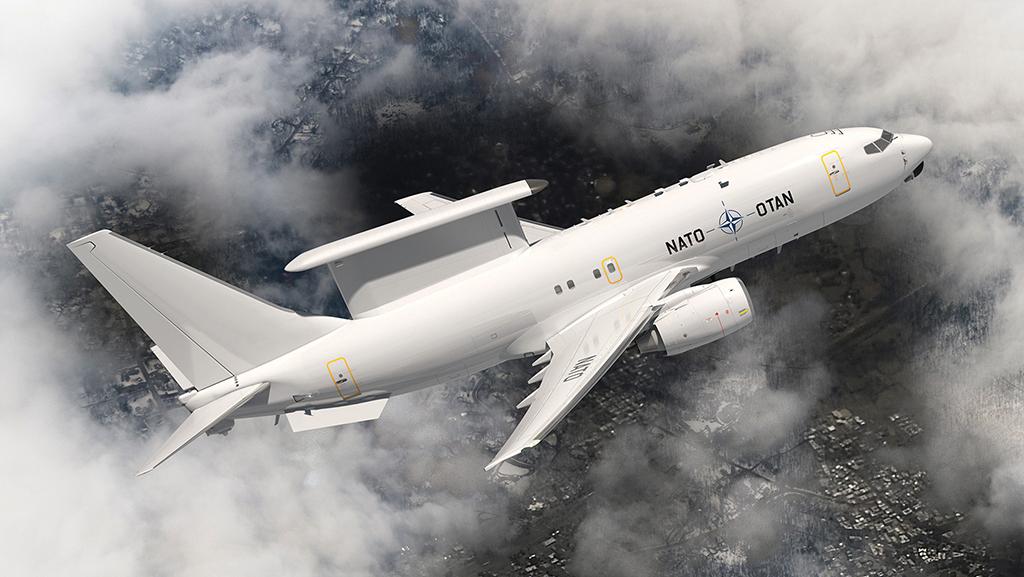
Like NATO’s E-3s, the E-7s are slated to be based in Germany and operate from a variety of forward operating bases in alliance nations.
NATO is set to follow in the footsteps of its British, Turkish and U.S. members by joining the Boeing E-7 operators club.
The alliance has outlined plans to buy six of the Boeing 737-based airborne early warning (AEW) aircraft to replace its current 14-strong fleet of E-3 Sentries and to meet the initial Alliance Future Surveillance and Control (iAFSC) requirement.
- NATO plans foreign military sale buy of six Boeing E-7 Wedgetails
- E-7 preferred over Saab GlobalEye and Northrop Grumman E-2D Advanced Hawkeye
- First NATO E-7 due to enter operation in 2031
With an initial operational capability planned for 2031, the organization is hoping for an orderly transition not only from the E-3—due to retire in 2035—to the E-7, but also toward the broader AFSC system of systems, which aims to provide multidomain surveillance from land, sea, space and air.
The E-7 is expected to contribute to the wider AFSC system along with autonomous air assets, space-based sensors, advanced tactical networks, multidomain connectivity and military cloud networks.
The selection of the E-7 by a consortium of nations—including Belgium, Germany, Luxembourg, the Netherlands, Norway, Romania and the U.S.—follows the December 2022 publication by the NATO Support and Procurement Agency (NSPA) of a request for information (RFI) for alternative AEW platforms. The RFI was driven by concerns about the ability of the 707-based E-3 to keep reliably flying into the 2030s (AW&ST March 13-26, p. 22).
Similar concerns drove the U.S. Air Force’s decision to buy E-7s and begin sunsetting its E-3 fleet.
Various airframers responded to the RFI: Saab proposed the GlobalEye, Northrop Grumman the E-2D Advanced Hawkeye and L3Harris a conformal AEW conversion of the Bombardier Global 6500.
But it was the E-7 that won out—unsurprisingly. It was judged the “only known system currently capable of fulfilling the strategic commands’ essential operational requirements and key performance parameters and also being available for delivery within the time frame required,” the NSPA tells Aviation Week.
Other considerations favoring the E-7 included its endurance, crew size, number of workstations and crew rest areas, surveillance coverage capability and growth capacity, as well as the risk associated with design and delivery.
NATO plans to purchase the Wedgetail version of the aircraft previously acquired by Australia and ordered by the UK Royal Air Force and U.S. Air Force. The Wedgetail version is generally considered more capable than the variants operated by Turkey and South Korea.
The E-7 is a known entity. The E-7Ts flown by the Turkish Air Force regularly operate alongside NATO E-3s, and an Australian E-7 is in Europe on a six-month deployment monitoring and protecting supply routes from Poland into Ukraine.
“Surveillance and control aircraft are crucial for NATO’s collective defense, and I welcome allies’ commitment to investing in high-end capabilities,” NATO Secretary General Jens Stoltenberg said as the alliance announced the decision on Nov. 15. “This investment in state-of-the-art technology shows the strength of transatlantic defense cooperation as we continue to adapt to a more unstable world.”
Boeing said it appreciated the confidence of the NSPA and participating NATO nations in the E-7. “We stand ready to support this Foreign Military Sale and deliver this exceptional capability that will enhance NATO’s readiness,” the company said.
But not everyone is happy with the decision. Sweden’s Saab acknowledged the NSPA’s decision but said it would “welcome further dialog” on the decision process.
“From a technological point of view, GlobalEye is meeting or exceeding all capabilities set forth in the RFI,” the Swedish company stated. “GlobalEye is pushing technology to levels that legacy thinking will miss out on.”
The number of aircraft being acquired has also prompted questions about the sustainability of the fleet—six would be fewer than half the number of NATO E-3s currently in service. But the NSPA says six is the “minimum number” NATO commanders report they require to “deliver the minimum operational capability for Supreme Allied Commander Europe’s Day 0 airborne air battle management capability.”
By comparison, the Royal Air Force is buying three E-7s to replace an original fleet of seven E-3s, and the U.S. Air Force plans to buy 26 E-7s to supersede its 30 E-3s.
Theoretically, the NATO fleet shrinkage should eventually be offset by the introduction of AFSC into service in 2035 and by an increasing number of organic AEW assets being acquired by NATO members. These include Italy’s Gulfstream G550 Conformal AEW aircraft and Poland’s recently purchased Saab 340-based Erieyes. Sweden’s two GlobalEyes, currently on order, also will likely become available for NATO use once the Nordic country joins the military alliance.
Meanwhile, Leonardo is continuing work on a €1 billion ($1.1. billion) Final Lifetime Extension Program for the NATO E-3s, with all 14 aircraft due to be completed in early 2027.





